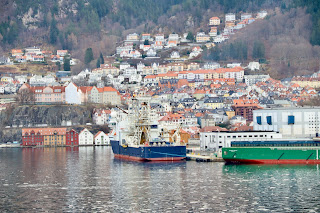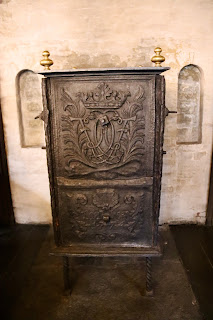Call it a senior's moment, but I was quite remiss not to mention Cruise Critic in the last post. Being ignorant of Cruise Critic is a positive thing, dear reader, and no thanks to Mary who cheerily introduced us to this erudite forum in the weeks prior to our departure. In short it is a website, but you need to become a member. There is no monetary cost, but the cost to your sanity is something else. Once you've joined, you can find your upcoming cruise, or look at others, and read the commentary from the members through a section called 'Boards' where a roll call group is created.
For our cruise there was, on completion, 21 pages of comments. I didn't count the number of individual contributors, however, from memory, one was from Scotland, one from England, two from Australia and the rest were from the USA. Not surprising given a Viking representative said that 85-90% of their business is from the States. Of course I am not one of the Australians who contributed to the pages. I lurked, dear reader, and maintained the safety of anonymity as the war of words was raged. Oh yes, it was quite nasty at times. Passive aggressive replies about dress codes, outright aggressive commentary about pre-booking shore excursions. Always concluding with some ludicrous, 'have a nice day' comment, while meaning the entire opposite. One person actually said, "I don't judge" while doing exactly that.
Who would have thought I would be demonstrating disrespect towards the staff by wearing jeans to dinner, as one overly judgemental person stated. I'm certain my jeans didn't impact on their wages and I've been treated nicely by suits and pearls as well as overalls and jeans. The reverse is also true, although there was more abuse from the nicely dressed. Money does not buy class.
 |
| Early morning heading to Bergen. |
Here is a link to the 'Boards' page, but you'll have to join for access. Good luck, it is a slippery slope.
Back to the agenda. Bergen. We have overstayed our welcome, not because of something we have done. Well, it is really. There is only so much to do in this beautiful town and the weather restricts some activities. When rain is likely for 239 days a year, consecutive days without rain are miraculous! We achieved this feat on our first two days here.
 |
| Cruising into Bergen. |
And so to today's title, It might as well rain until September. A 1963 classic from Carole King. It felt like it was going to rain until September. The locals are all very stoic about it. Dress appropriately and the rain is a minor inconvenience. Interesting in a town that is eminently walkable.
I'll break up the next section into the tourist attractions we visited as part of the cruise onshore experience. We were aware that opening hours can be seasonal. This is the lesser of the two shoulder seasons and some attractions are open for limited hours on one day a week.
 |
| Beyond the port, Bergen is etched into the hillside. |
As previously stated, we arrived in Bergen a couple of hours late and all the tours were pushed back. This actually meant we would not be able to make our Chef’s Table reservation that evening if we attended our last shore excursion. That was still hours away and we boarded a bus for a 4.5 hour Panoramic Bergen tour which proved, happily, to be more off the bus than on.
 |
| Decorations on houses were used instead of addresses. |
 |
| Bryggen. |
Ani then deftly switched the point of the walking tour and made his way through the group. Those that had situated themselves next to him were now at the rear. I’m sure my smirk was visible. One aging man (insert country of prejudice, oh alright, he was American) with a walking stick was clearly unhappy with this new arrangement and stepped from the footpath onto to the road to gain ascendancy and the front of the group. Sadly, the driver of the adjacent car anticipated his stupidity and drove around him as his wife called out, “Be careful, Jim.” One deftly placed shoulder on my behalf could have ensured his permanent removal from our group.
 |
| Bryggen Nightclub. Definitely no smoking. |
Obviously, fire was a significant issue in a community of wooden structures and the area has burnt down several times. This, despite the absolute prohibition of any fires in any of the houses for either heating or cooking purposes. The subsequent rebuilding on dodgy foundations has had its impact and some buildings appear not to have been constructed with the use of a spirit level or string line. Extensive restoration work is being undertaken both inside and underneath several of the iconic houses as the sinking water table is impacting negatively upon the already undermined foundations – hence the list to one side. In fact, they are channelling natural rainwater run off into pits underneath the houses in a bid to keep the water table afloat.
 |
| Of course it is level. |
While timber was a plentiful resource, fire is a necessity in such a cold, wet climate. Despite this, and the abundance of stone, it was rarely used as a construction material. A couple of houses and the church were the only evidence of common-sense building.
 |
| The oldest building in Bergen is made of stone. |
The brass manhole covers that dot the Bryggen and wider area are decorated with a symbolic graphic of Bergen.
 |
| Very decorative. |
 |
| A bull's penis used to whip those who break the rules. |
 |
| Where the important people sit. |
 |
| The stove heating the hall, fed from the kitchen. |
 |
| A row of pots in the kitchen. |
 |
| Looks good from the outside. |
 |
| That's about all we could see. |
The drive was a fascinating look at Bergen and its history. We passed the fish market and were recommended a restaurant to try. The outdoor market has yet to open for this season. Not far away was another community of wooden houses, all painted white. They were almost totally destroyed in WWII but a rebuilding and restoration program has ensured they will be around for a while longer.
 |
| Flowers are hard to come by at the moment. |
Up the hill we went past a grassy, park-like area with views back to the harbour. Quite a pleasant spot, until it was explained that is where Bergen’s witches were burned at the stake. It seems an intelligent, opinionated woman was not trusted in Norway either.
The “new” church, was built in 1763. Not quite so new. Back in the day it was given the tag and it has stuck. The new church is visible from many parts of Bergen and I’m sure it a significant landmark. However, it is currently wrapped in plastic, Laura Palmer style, as work is carried out on the exterior of the building.
 |
| They love trolls in Norway. |
There is an interesting statue of Henrik Ibsen that turned out to be across the road from our hotel. Ani described him as “the second greatest playwright in the world. After Shakespeare.” Hmmm. Not sure about that. How about Chekhov? Or Pinter? Or Beckett?
 |
| Ibsen has crazy eyes. |
We also drove by the area where it is mostly student accommodation. Bergen, after all, boasts two universities and the students account for almost 20% of the population. In contrast, we also toured the most expensive suburb. What made it so expensive? Well, price obviously, but why? It was the part of the town that received the most sun. Now that I completely understand.
And that's where I'll end it for today. I need to split Bergen into two posts otherwise you'll never get anything done, dear reader.
Until next time.

Cruise Critic - you’re welcome!
ReplyDeleteHaha. I've unsubscribed now.
ReplyDelete